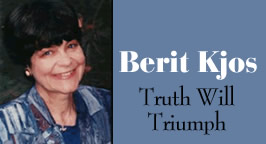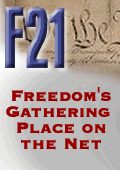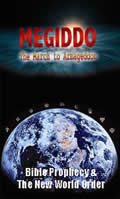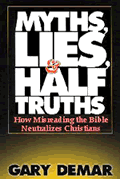Other Kjos Articles:
Harry Potter and The Postmodern Church
Popular Occultism and the Consensus Process
Legalized Mind Control Part 1Harry Potter And The Chamber of Secrets
Part 1
Hegelian Alchemy And
Mind Changing Games
Part 2
Pagan Fantasies Join The Digital Explosion
Part 3
The Global Message Behind Mystical
Thrills
NARNIA - BLENDING TRUTH AND MYTH
By Berit Kjos
December 9, 2005
NewsWithViews.com
"...the children discover a charming, peaceful land inhabited by talking beasts, dwarfs, fauns, centaurs and giants that has become a world cursed to eternal winter by the evil White Witch, Jadis. Under the guidance of a noble and mystical ruler, the lion Aslan, the children fight to overcome the White Witch's powerful hold over Narnia...."[1]
"C.S. Lewis is someone who paints a picture and lets you imagine the rest. To me it's about making a movie which lives up to my memory of my book rather than specifically the book itself. And it needs to live up to everyone else's memories and that is what my challenge is - to make it accessible and real.... I want it to feel real...."[2] Director Andrew Adamson
The movie opens with a glimpse of the cruel, violent world of reality. Air raid sirens shriek through the night as Nazi bombers drone overhead, dropping their deadly bombs. The Pevensie family heads for the bomb shelter, well aware of the ongoing dangers that threaten in war-torn London. Soon afterwards the four children board a train and head for safety at a country mansion owned by a mysterious old professor. They are about to discover the thrilling world of fantasy.
As most of us read in "The Lion, the Witch and the Wardrobe" by C.S. Lewis, the four children explore their new home and grope their way through a magical wardrobe into the cold, wintery world of Narnia. Here -- as in the ancient myths that had captivated Lewis' heart -- animals talk, witches bewitch, curses turn flesh into stone, and the veil between physical reality and spiritual fantasies fade away. Myth and truth merge into more compelling illlusions, while good and evil are redefined to fit the new story.
"The book is about imagination," says Roger Ford, the production designer of Disney's version of Narnia. "So the imagery is provided by the child's and the reader's imagination." But, unlike books, movies implant ready-made images. "The challenge of a film-maker is to live up to and exceed the people's imagination," continues Ford, "and really transport them to another time and place."[3]
Today's digital magic fulfills that function all too well! But where does this movie transport the minds of our children? What kinds of enticements does it feed to their human nature and emotional appetites? What suggestions will leave lasting imprints in their memory? Those are the question that Christian parents need to ask. And one word answers all three: the world of the occult.
The enticing pagan worlds nurtured by C.S. Lewis and his myth-making friends were not inspired by God's Word or Spirit. Their stories grew out of lifelong immersion in the beliefs, values, rituals, languages and lifestyles of former pagan cultures.
The white witch, Jadis -- the self-professed Queen of Narnia -- emerged from that pagan worldview, not from a Biblical frame of reference. Her ritual sacrifice of Aslan has more in common with the ancient blood sacrifices to cultural gods ( Hindu, Mayan, Inca, Babylonian...) than with the crucifixion of our Lord. Small wonder the movie director chose a sacrificial setting for Aslan that looks strangely like the ancient ritual stones and pillars at Stonehenge, now a gathering place for the world's fast-growing networks of neopagans.
"Earlier in his life, Lewis visited the ruins at Stonehenge, a mysterious circle of giant prehistoric stones in Southern England. In her book, Journey into Narnia, Kathryn Lindskoog notes, 'The stone that is lowest at Stonehenge is called the stone of sacrifice because people suspect that humans were bound and stabbed there in evil ceremonies thousands of years ago.... It's almost certain that Stonehenge gave Lewis the idea of the Stone Table."[4]
Unlike Jesus, our Lord, Aslan negotiates the terms of the "ancient magic" with the white witch. And unlike God, Aslan attributes the ultimate victory to the humans, not to his own plan and power.
"The future of Narnia rests on your courage," the lion told Peter before his sad departure. Soon afterwards, this commissioned knight in shining armor would ride into the fierce battle on a snowy white unicorn, wielding a glimmering sword.
Does this picture remind you of the Armor of God (Ephesians 6:10-17) or the Sword of the Spirit? If so, it's a misleading match. That victorious Sword is the eternal, unchanging Word of God. It has no place in the myth of Narnia.
To illustrate this discrepancy between Biblical truth and Narnian fantasy, we will use God's armor as an outline. It disproves the modern assumption that Narnia is a Christian allegory -- a notion Lewis himself denied. According to Christianity Today, "not only was Lewis hesitant to call his books Christian allegory, but the stories borrow just as much from pagan mythology as they do the Bible."[5]
In fact, those who want to see Aslan as Jesus Christ would have to do some mental gymnastics. The two opposites simply will not match unless God's truth is conformed to the human imagination. Sad to say, such spiritual compromise is happening every day. And the better the counterfeit, the more deceptive is its power.
God's Armor -- a summary of the true Gospel -- is made up of six parts.
1. The Belt
of Truth -- The vital truth about God and His plan for redemption
2. The Breastplate of Righteousness -- The truth about our need
for the cross and God's righteousness
3. The Sandals of Peace -- The gracious gift of the Prince of
Peace to those who walk in His Truth and Righteousness
4. The Shield of Faith -- Putting all our trust in the sovereign
power and love of our King and His Word.
5. The Helmet of Salvation -- Keeping our eyes fixed on the hope
of His victory today and forever.
6. The Sword of the Spirit -- His Word, hidden in our hearts,
and wielded against any enemy to peace that might come against us.
These parts become all the more significant in light of the fact that Jesus, at various times, identified Himself before His disciples as Truth, Righteousness, (Prince of) Peace, our Salvation, and the living Word.[6] When you put on God's armor, you "clothe yourselves with the Lord Jesus Christ." (Romans 13:12-14) He becomes your hiding place and your shelter in the storm. Hidden in Him, you can count on His victory, for He not only covers you as a shield, He also fills you with His life.
1.God's TRUTH
�The movie... is a great tool for the Church to help people understand the truth of the Gospel of Jesus Christ," wrote Ted Baehr, founder of MovieGuide. "Very, very few people will see the slight divergences that the movie takes from the novel."[7]
The last statement may be true. Caught up in the thrilling high tech fantasy, few are likely to notice the changes in the script. But the first sentence should raise concern. How will this movie help people understand the truth of the Gospel? What is actually true in this so-called "Christian allegory?"
Dr. Baehr gives a partial answer in the following summary. What gross distortions of the supposed "truth" do you see here?
"A prophecy says that four sons and daughters of Adam and Eve will come to Narnia and help Aslan... free Narnia from the White Witch. To thwart the prophecy, the White Witch has told everyone that, if they see a son or daughter of Adam and Eve, they should kidnap and bring them to her....
�...the resurrection romp with Aslan, Lucy and Susan has also been eliminated, and the movie focuses more on the children being the solution to the evil in Narnia when, in fact, the victory is Aslan�s.... [The children] are heirs to the victory that Aslan wins on the stone table, and Jesus Christ won on the cross.... In fact, the movie is a very clear Christological allusion, or imagining, of the story of Jesus Christ. The minor changes do not take away from that meaning in the book....
"Andrew Adamson ... understands the element of sacrifice and redemption, but his concern was for the empowering of the children. ...his love for the original source ultimately keeps the movie on target.�[7]
Since Adamson's focus was on "empowering... the children," it makes sense to give them (rather than Aslan) credit for the ultimate victory. It also helps explain Aslan's twisted message:
"The future of Narnia rests on your courage."[8]
While that statement should disturb those who love the Gospel, it matches Narnia's ancient prophecy very well. To us, the word "prophesy" implies God's omniscient (foreknowledge of future events) revelation of what lies ahead. Because we know Him and trust His Word, we take seriously the precious Old Testament prophecies concerning the coming Messiah. Everything He has told us will or has already come true! Jesus came and gave His life for us! He will come again for His people! But Narnia's prophecy promises no such Savior. In stark contrast, it promises that four humans will come and save the land. What a sham to call this deceptive story a picture of truth!
If that appalling lie colors our understanding of the true Gospel, we will see ourselves as co-saviors. We will pat ourselves on the back, rather than humbly and joyfully praise our God for His amazing grace in our weakness! Translated into the language of the gospel, this view implies that Jesus' death and resurrection was not sufficient to save His people. Instead, God depends on us to accomplish His salvation. That untruth has already become a vital marketing ploy in today's man-centered Church Growth Movement.
The following comment by Joseph Pearce (Tolkien's biographer and author of a new book about C. S. Lewis) illustrates the persuasiveness of these myths. It applied to Lewis as well as Tolkien:
"... the power of Tolkien lies in the way that he succeeds, through myth, in making the unseen hand of providence felt by the reader. In his mythical creations, or sub-creations as he would call them, he shows how the unseen hand of God is felt far more forcefully in myth than it is ever felt in fiction. Paradoxically, fiction works with facts, albeit invented facts, whereas myth works with truth, albeit truth dressed in fancy disguises.�[9]
Do you see the strange reasoning? If the mythical realm of magic "makes the unseen hand of providence felt by the reader," what message does it actually teach? What new "truths," feelings and perceptions do people "take home" when they leave the theater?
Our wise God has a far different view of the human imagination than either Tolkien or Lewis, and He is well aware of the its power to inflate lies and distort truth. Therefore, He warns us repeatedly that "the imagination of man�s heart is evil from his youth." [Genesis 8:21]
|
Subscribe to the NewsWithViews Daily News Alerts! |
To better understand the twisted Gospel taught through this mythical series, Part 2 of this Narnia series will look at the strange creation story told in "The Magician's Nephew," the book that precedes "The Lion, the Witch and the Wardrobe" in the 5-set Chronicles of Narnia.
"Be diligent to present yourself approved to God, a worker who does not need to be ashamed, rightly dividing the word of truth." 2 Timothy 2:15
Footnotes:
1,
The Chronicles of Narnia: The Lion, The Witch and The Wardrobe (2005)
Video
Clips & Multimedia
2,
dvddungeon.com/news/news.php?id=4207
3,
Narnia Trailer
4,
A Christian
Family Guide to the Chronicles of Narnia
5,
Josh Hurst, "Into
the Wardrobe and Straight to Hollywood," Christianity Today (11/07/05)
6,
A
Wardrobe From the King
7,
Chronicles
of Narnia
8,
The
World of Narnia
9,
The Letters of J. R. R Tolkien, Humphrey Carpenter, editor (Boston:
Houghton Mifflin Company, 1981, page 201.
Sign Up For Free E-Mail Alerts
E-Mails are used strictly for NWVs alerts, not for sale
Berit Kjos is a widely respected researcher, writer and conference speaker. A frequent guest on national radio and television programs, Kjos has been interviewed on Point of View (Marlin Maddoux), The 700 Club, Bible Answer Man, Beverly LaHaye Live, Crosstalk and Family Radio Network. She has also been a guest on "Talk Back Live" (CNN) and other secular radio and TV networks. Her last two books are A Twist of Faith and Brave New Schools. Kjos Ministries Web Site: http://www.crossroad.to/index.html
Virtually banned from American schools in the early sixties, the Bible has faced a rising onslaught of wrath, ridicule, and legal assaults.











